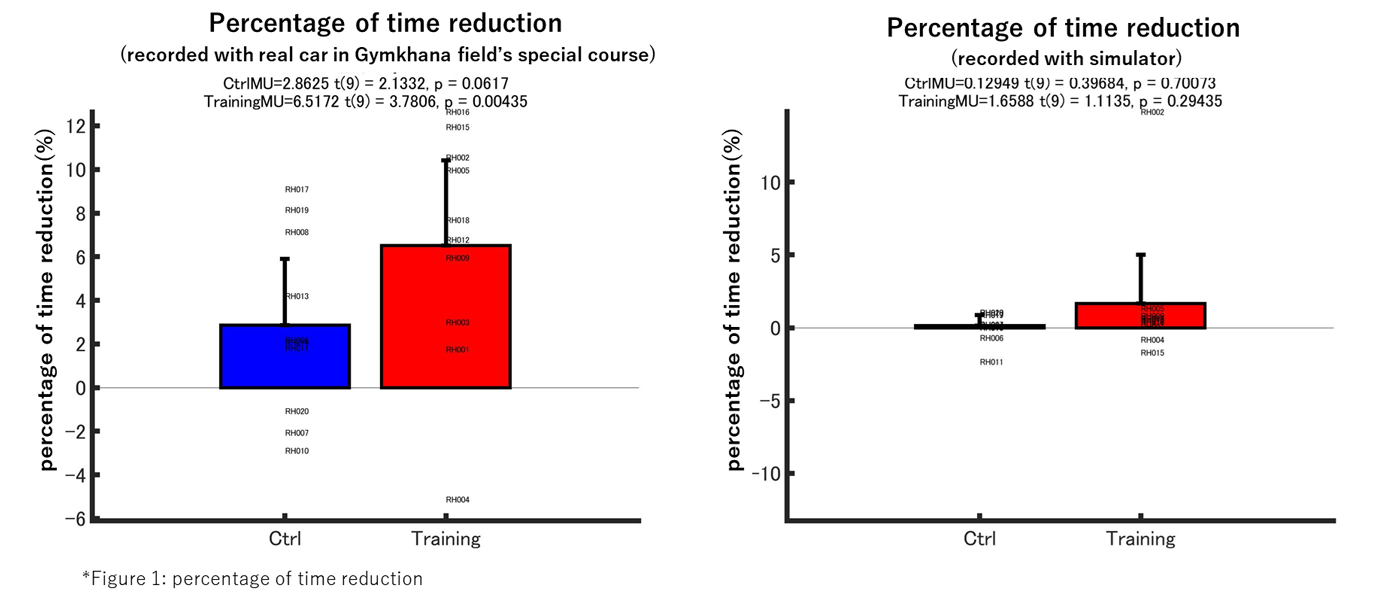- KDDI HOME
- Corporate Information
- News Releases
- 2022
- 20 gamers participated: BrainTech Paves the Way for Real Racers Project
20 gamers participated: BrainTech Paves the Way for Real Racers Project
―93.6% have failed to achieve their dream of becoming a professional racer, and now eSports could be the gateway to this dream.―
- KDDI Corporation
- IROC Corporation
- VIE STYLE Corporation
- Racing Hero Inc.
November 18,2022
KDDI Corporation (headquartered in Chiyoda-ku, Tokyo; Makoto Takahashi, President & CEO; hereinafter "KDDI"), IROC Corporation (headquartered in Nagoya City, Aichi Prefecture; Takuma Koga, CEO; hereinafter "IROC"), VIE STYLE Inc. (headquartered in Sumida-ku, Tokyo; Hiroki Hayashi, CEO; hereinafter referred to as "Racing Hero"), together with many partners including e-sports gamers who enjoy racing games (hereinafter referred to as "e-racer") and automobile manufacturers, have launched a experimental project "e-Racer Project; to Carry Everyone's Dreams" (hereafter, the "Project") from July 20, 2022 to September 26, 2022. The Project was conducted to develop a technology (hereafter, the "Technology") to improve driving techniques in real cars by enhancing the cognitive abilities of the brain through training using BrainTech, which combines brain science and IT, and e-sports. The project is aimed at developing a technology that will improve driving techniques in real-world vehicles.
In this project, we expanded the demonstration experiment [![]() 1] conducted in fiscal 2021, and 20 e-racer test drivers participated in the project, measuring their driving times using actual vehicles and other means and conducting brain training for approximately four weeks.
1] conducted in fiscal 2021, and 20 e-racer test drivers participated in the project, measuring their driving times using actual vehicles and other means and conducting brain training for approximately four weeks.
As a result, the 10 e-Racers who received the brain training improved their time by 2.2 times more, compared to the 10 who did not receive the training. This confirmed the effectiveness of the brain training.
In the future, KDDI will use this technology to develop a range of e-sports that have low hurdles to overcome in order to get closer to becoming an actual car racer.
We will support people who challenge themselves by creating brain training apps based on the result of this project.
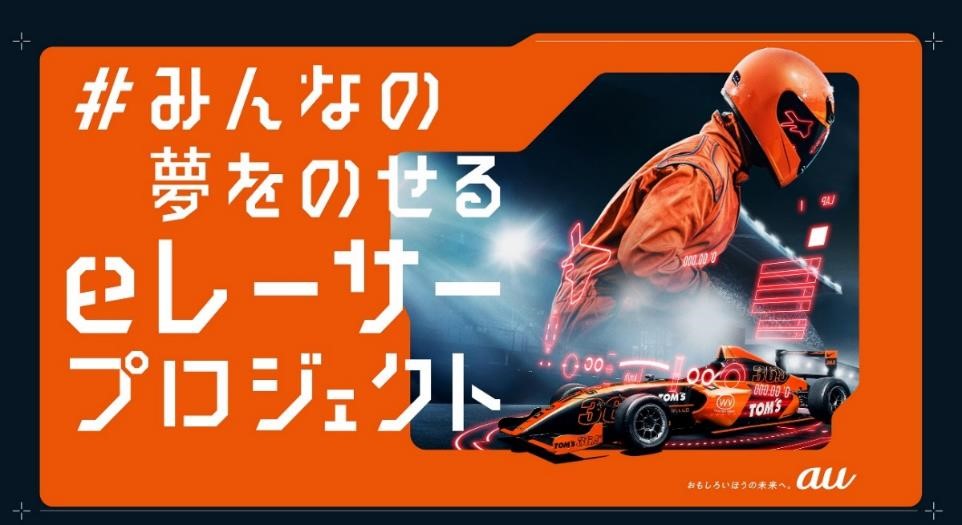
■70.5% give up due to cost; steep road to becoming a racer
Generally, to become a racer, one starts training in racing karts at an early age, gains experience in real cars as he or she grows up, and then joins a specialized training team.
Therefore, it is said that it is a hard road to achieve the dream of becoming a racer, which requires not only his or her own efforts but also the support of his or her family and a large amount of money.
In a survey conducted by au, 93.6% of those who had aspirations of becoming a car racer said that they could not fulfill them as a career, and 99.0% said that they thought it was too hard to become a car racer.
As for the reasons for giving up, 70.5% of the respondents stated that they gave up because of the cost, 49.5% because they did not know where to start, and 42.5% because they did not have a place to practice. From these results, it can be said that racers are representative of "dreams that are difficult to fulfill due to environmental factors".
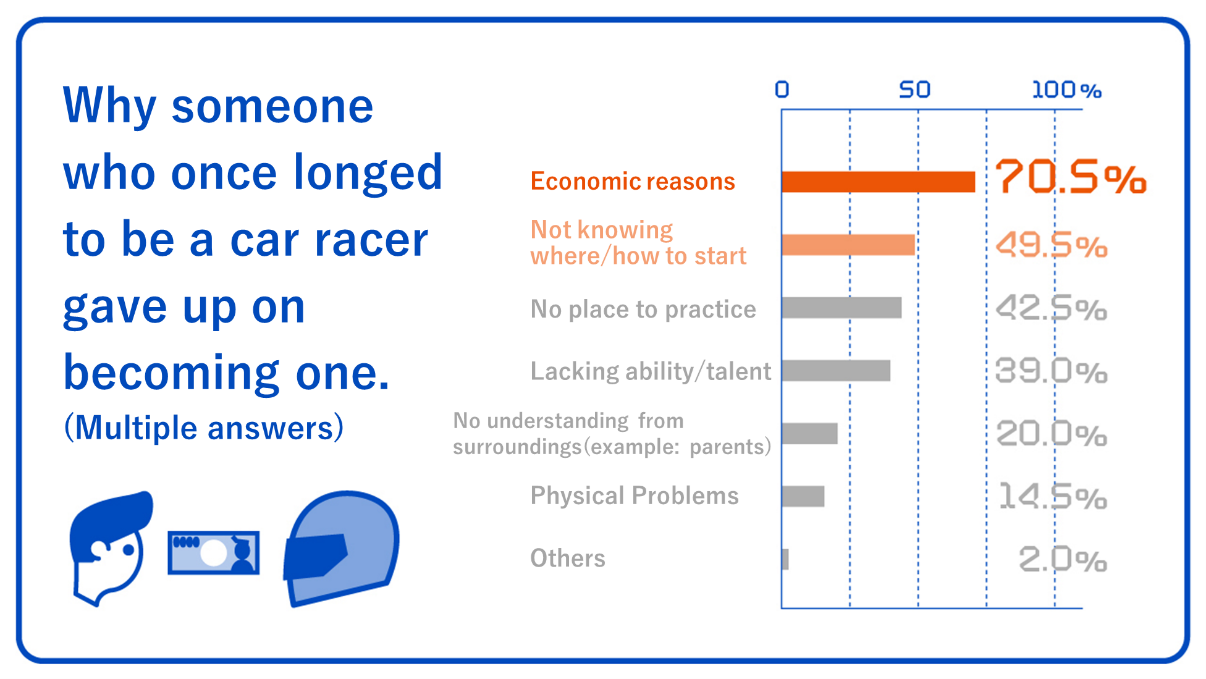
<table: Why did someone who once wanted to be a car racer give up on it?>
■Games are the gateway to becoming a racer. Brain Tech helps you challenge your dreams.
This is why we focused on a training method that uses a driving simulator and Brain Tech to develop the driving techniques required for driving a real car.
Once this method is perfected, the efficiency of growth can be improved by repeating the practice while checking the effect of brain training on a driving simulator through repeated achievements in racing games and other e-sports.
This makes it possible to become a professional racer with much less time and money spent practicing on a real car, changing the conventional wisdom of what was thought to be required to become a racer. And also eco-friendly.
Furthermore, the project has also created opportunities to participate in actual races. e-racer Yuito Sasaki, who participated the Experiment in 2021, will compete in the Toyota Gazoo Racing Yaris Cup West Japan Series at Okayama International Circuit on November 19 and 20, 2022. In addition, the 2 e-Racers who participated in the 2022 project have entered the EV Kart Race to be held at Motor Sports Japan 2022 (hosted by the Japan Automobile Federation (JAF)) on November 19, 2022. By making this project a gateway from e-racer to real racer, we will also support them in their attempts to achieve their dreams.
■Accelerate technology development with automotive, racing and e-sports partners
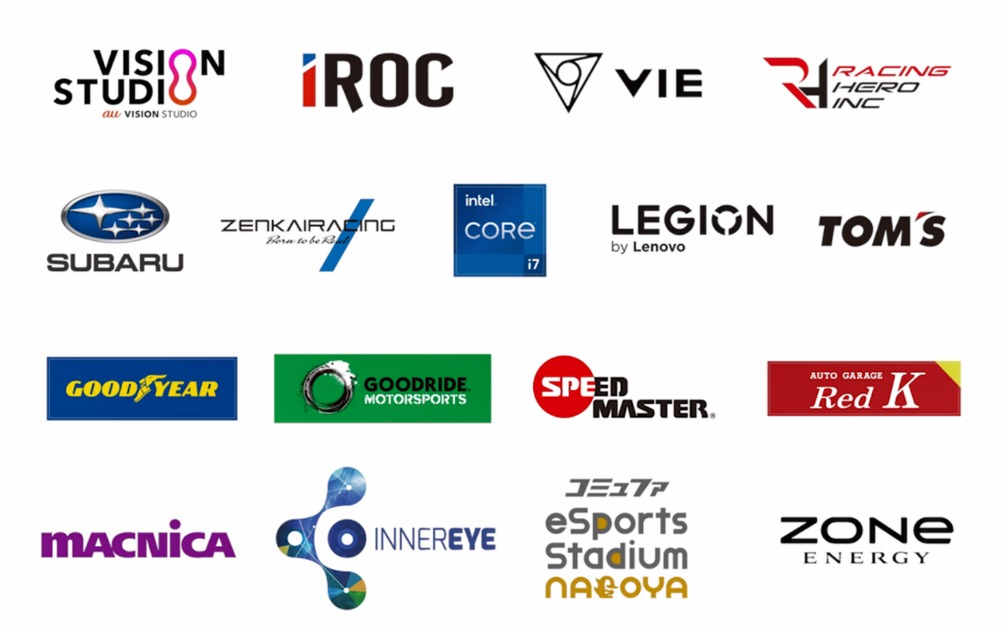
<logos: Companies participating in this project>
In addition to four major companies, KDDI, which is responsible for the overall development of this technology VIE STYLE of brain science, IROC, which provides driving simulators and driving technology support, and Racing Hero, which manages e-racer, this project is being conducted with the cooperation of SUBARU Corporation ("SUBARU") and SUBARU Driving Academy (hereinafter referred to as "SDA"), eight companies that have knowledge in various industries, including support for real car training and provision of PCs , will accelerate technological development.
Through this project, au will support many people who have to give up on their dreams for various reasons by using technology to help them take on the challenge of their dreams.
For details, please refer to the attached sheet.![]() Real Racers Project | au × MOTORSPORT | au (in Japanese only)
Real Racers Project | au × MOTORSPORT | au (in Japanese only)
<Attachment>
About the "e-Racer Project to carry everyone's dreams"
1. Outline
The "e-Racer Project to carry Everyone's Dreams" is a project to develop technology to create a path for those who want to become car racers in the future, without giving up due to environmental or economic reasons.
A total of 33 people, including 20 e-racer drivers recruited from the general public and 13 SDA drivers, measured their driving times in real cars and driving simulators, conducted brain training, and advanced the development of this technology.
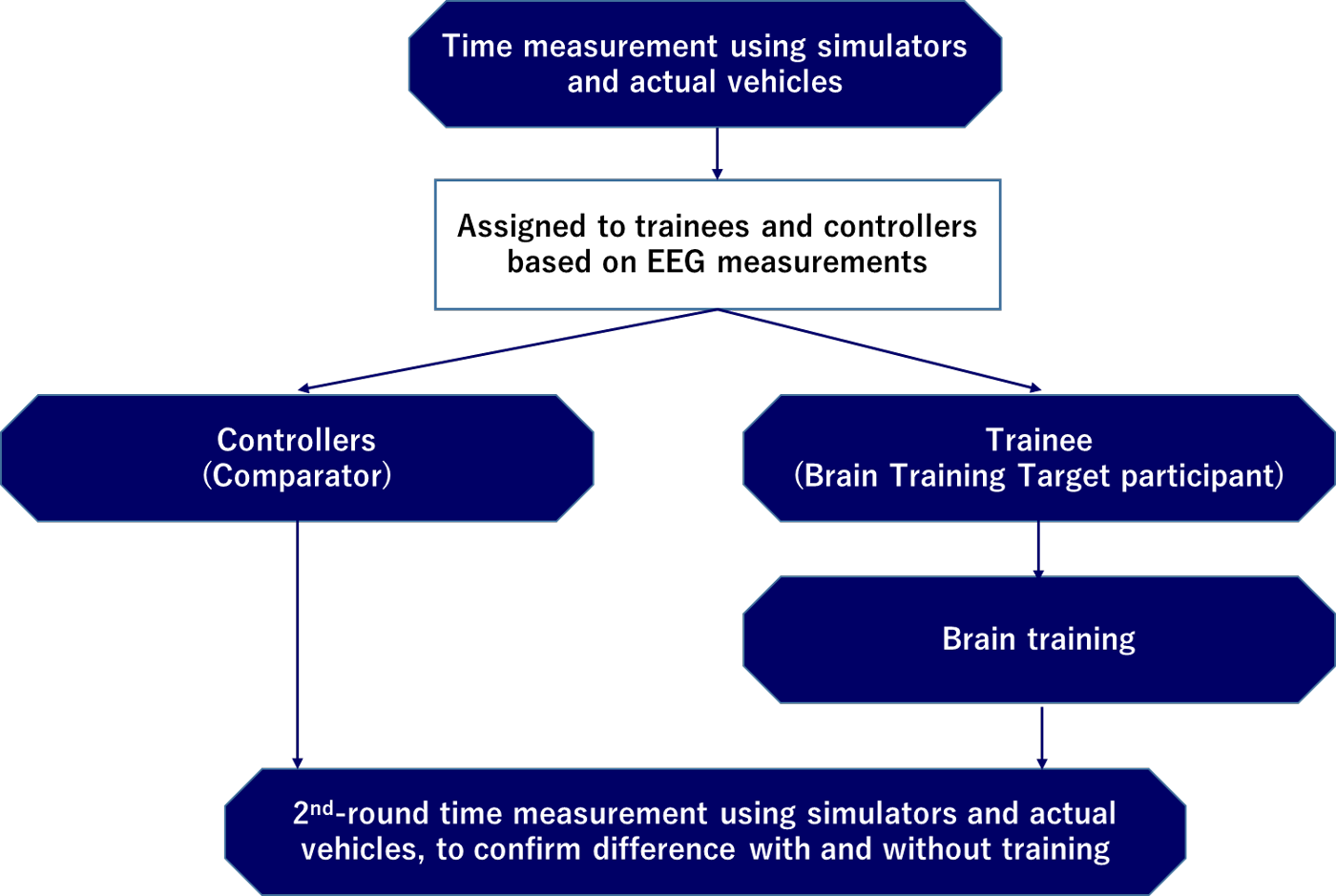
<Project overview>
<The flow of this project>
| item | contents | Date conduvted |
|---|---|---|
| measurement session (1st round) |
The driving time and brain waves were measured at Tsukuba Circuit using an actual car and a driving simulator. In addition, five cognitive task/psychological scale responses were administered to identify cognitive abilities that correlate with driving performance. Based on the measurement results, we identified the cognitive abilities of the training target. |
August 1, 2022 |
| brain training (Trainees only) |
Assigned 10 participants those who conduct brain training (hereafter referred to as "trainees") and 10 comparison subjects (hereafter referred to as "controls") who did not receive brain training. Brain training was conducted once a week. (4 times in total) |
Late August 2022 to mid-September 2022 |
| measurement session (2nd round) |
The measurements were taken at the Tsukuba Circuit, as in the first round. | September 26, 2022 |
2. Technology development in this project
(1) Contents of verification in this project
In this project, the following two programs were conducted simultaneously with a total of 33 people, including 20 people recruited from the general public and 12 SDA drivers, in order to verify this technology.

<Driving image of the actual vehicle>

<Driving images in the T3R Simulator>
| program | contents |
|---|---|
| (1) Confirmation of the reliability of the verification results for FY2021 | We implemented the same curriculum as in FY2021 for participants recruited from the general public, and confirmed whether brain training (neuro-feedback training + cognitive training) would lead to improved driving times on the driving simulator. |
| (2) Confirmation of which driving operation is affected by the contents of the brain training | In order to confirm how brain training (neuro-feedback training) affects which driving operation, not only driving simulator but a real car drive test has conducted. |
(2) Verification by SUBARU and SDA
SDA drivers also underwent the same program as the e-racer in a SUBARU-owned training vehicle, and in collaboration with the SUBARU Technical Research Institute, various data acquired by loggers attached to the vehicle, in-car camera images, driving lines using high-precision GNSS, and line of sight information acquired by eye tracking were comprehensively analyzed to confirm the differences from the e-racer verification results.
(3) about brain training
Progress in brain science research, it has been reported that motorsports racers have a faster reaction time than the general public [![]() 2]. A recent study of more than 2,000 children also suggests that gaming experience is associated with improved cognitive abilities such as working memory and inhibitory control (the ability to restrain actions and reactions). [
2]. A recent study of more than 2,000 children also suggests that gaming experience is associated with improved cognitive abilities such as working memory and inhibitory control (the ability to restrain actions and reactions). [![]() 3].These results suggest that the cognitive abilities of the brain are behind the high performance of driving and e-sports , and that the improvement of actual competition performance through and training is expected.
3].These results suggest that the cognitive abilities of the brain are behind the high performance of driving and e-sports , and that the improvement of actual competition performance through and training is expected.
Based on participants' measurement data, this project developed a training menu to improve [1] sensorimotor skills and [2] emotional regulation skills, which were found to correlate with brain training and driving skill improvement.
<Training Menu>
| Training Items | contents |
|---|---|
| [1] Neuro-feedback [ |
After performing neuro-feedback aimed at upregulating a specific frequency band (enhancing the EEG component of that frequency), which has been suggested in previous research [ |
| [2] Emotion control training by neuro-feedback | By using brain information decoding technology that estimates the emotional state of an individual based on the brain waves of a specific emotion induced by oneself, it is possible to perform neuro-feedback that self-induces the desired emotion [ |
(4) Demonstration results
3. Structure
| name of company | role |
|---|---|
| KDDI | Overall project management (overall planning and design, partner arrangement and management, business model design) |
| IROC | Provision of the racing simulator "T3R Simulator", support for simulator use, and total advisory services such as setting up hypotheses and raising issues from the real driver's point of view |
| VIE STYLE | Develop and implement EEG analysis and brain training programs |
| Racing Hero | Management of e-sports players, qualifying races |
| SUBARU | Drivers attendance, provision of equipment, joint research Using SDA drivers and vehicles, the relationship between the training program and actual driving operations is analyzed jointly with the SUBARU Technical Research Institute. |
| Intel Corporation, Lenovo Japan Ltd. | Review of the configuration of the simulator and the PC used for EEG analysis and neurofeedback of the athletes, and cooperation with the equipment. |
| TOM'S Corporation | Utilization of TMS driving simulators and support for actual car training through "Formula College" (planned) |
| Goodyear Japan Ltd. | Provision of a vehicle for actual training, opportunities to drive in a Yaris Cup car, and lectures by professional drivers (to be implemented). |
| GOODRIDE MOTORSPORTS | Advisory services for various verifications, provision of experience opportunities for test subjects, and cooperation with contracted driver Masao Yamanaka |
| Speed Master Co. | Provision of oil for the vehicle used in this project to acquire data on subjects (hereinafter referred to as "measurement vehicle") |
| Red K Co. | Maintenance of measurement vehicles |
| Inner eye Inc. | Provide "Sense Plus" system for measuring and analyzing cognitive status and brain wave analysis |
| MACNICA Inc. | InnerEye's Sense Plus brain wave measurement and analysis support for drivers |
| Suntory Holdings Ltd. | Provision of "ZONe ENERGY" beverage for participants in the experiment |
| Commufa eSports Stadium NAGOYA | Provide location and facilities for brain cognitive skills training |
4. eSports racer-turned-real racer Tomibayashi's comment

"I was lucky enough to have parents who loved cars and racing, so they understood me, but I don't think I would have had the financial means to continue racing karts from a very young age. Even when I became a real racer, the amount of practice and funding made it difficult. I thought this project was a great way to bring the real and virtual worlds together, and I hope that this will encourage more drivers to pursue their passion for racing."
[Yusuke Tomibayashi]
Tomibayashi won the Gran Turismo World Championship in 2016, and in 2018, he entered real car racing as the world's first "eSports Racer and Real Racer" . In the KDDI experiment conducted in FY2021, he cooperated in the development of the project as a mentor.
(Reference)
■"Survey on Car Racers" asked 200 people who had aspirations to be car racers.
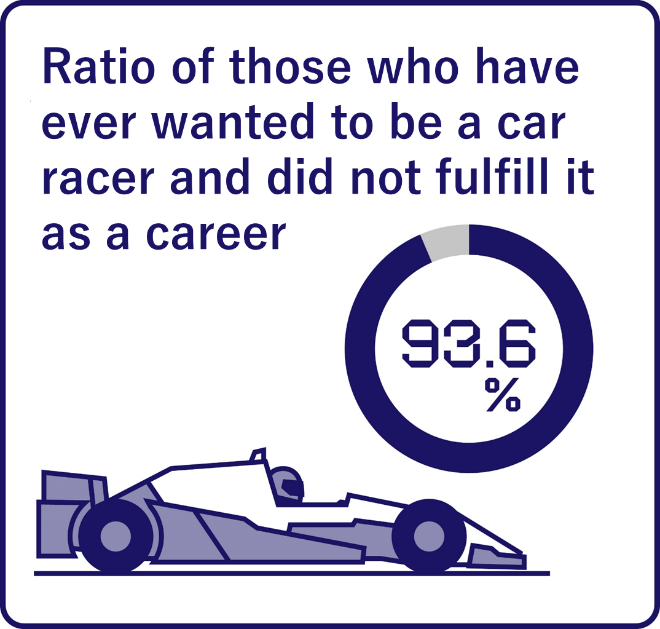
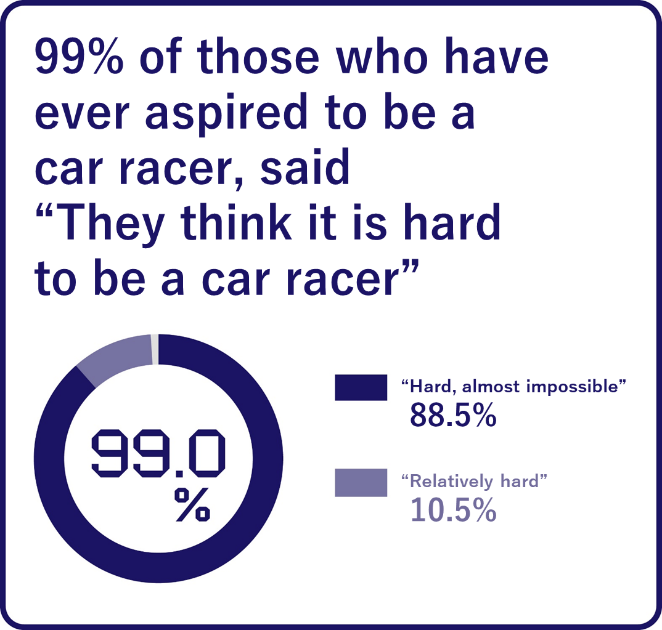
<Survey Summary>

